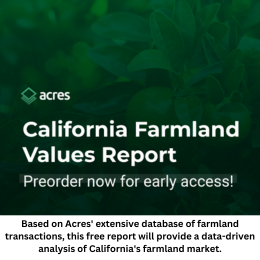April 25, 2017
Investment dollars into food and agtech startups reached a record $4.6 billion in 2015 – double that of the previous year, according to AgFunder. In 2016, although investment dollars fell back to $3.2 billion, the number of deals increased by 10 percent, reaching a record 580.
Although impressive, and resulting in breakthrough technologies, a panel of pioneers in the agtech space at Global AgInvesting 2017 in New York discussed what is needed beyond capital to see real success for agtech innovation, and opened a window to investor sentiment through real time surveys of attendees.
When asked, “In the next five to 10 years, how will data drive agtech influence your decision making?”
Sixty-eight percent of attendees responded: “It is the future and those who are not on board are behind,” while another 29 percent responded “It is important, but not significant.”
Clearly a vast majority of investors rank data driven agtech innovation as at least “important,” with nearly 70 percent seeing the space as “the future.” This sentiment is reflected in the dollar amounts being seen deployed to the space. However, leaders within the industry note that there are disconnects existing between technologies that need to be resolved in order to see true advancement.
“There are maybe 500 to 2,000 real agtech companies out there and they’re storing data in 500 different ways,” said Matt Waits, CEO of SST Software. “Everyone wants to apply their logic to the system – all the effort is going into rebuilding the same basics.”
Karl Gutbrod, CEO of meteoblue AG agreed, and expanded upon the point saying, “Our job as an industry will be to take the tech from each of these boxes and transform it into something useful.”
The first step toward achieving this would be to establish a unified system of standards that would foster the ability to synthesize information into informed decisions.
“This is the first thing that has to happen – standards between us. And there is going to start being some very big players that are good at making these connections,” said Gutbrod.
Continuing the conversation, Waits added, “We haven’t connected the dots very well in this industry. Someone will have to build adapters that translate to a common language – but it’s inefficient. We basically speak different languages, and we have to get to a common language. We’ve been at it for a decade, and haven’t made much progress.”
Beyond adapters and a unified language, challenges to ‘connecting the dots’ seemingly extend beyond industry into the political arena.
“In South Africa, Australia, the U.S., Canada – things are done in a similar fashion, but the underlying data structures, the rules around how you handle yield data – those things could be achieved if we had the political alignment to do it,” added Waits.
The need to ‘connect the dots’ is certainly an undercurrent that flows below the surface of the entire agtech space, however, the question of data ownership is undeniably tied into the theme.
“Everybody wants to be the one with the data and nobody really wants to share,” said Waits. “Companies are saying ‘I don’t want to play’. They’re just going to put up enough capital behind their tech to have a large share of the market.”
It all begs the question – given this disconnected, competitive landscape – who, or what companies will surface as those most able to capitalize upon these market conditions?
“Objective traceability data-driven companies,” said Gottfried Pessl, CEO of Pessl Instruments GmbH. “Like SAP companies, or unbiased companies – they will be big in the future.”
Disconnection and bias are certainly issues that have been identified as needing to be address by those within the space, but the challenge of adoption is never far from the conversation.
Damien Lepoutre, president of GEOSYS, sees the issue of adoption as the responsibility of those in the industry developing the technologies.
“Our job is adoption,” said Lepoutre. “It is one thing to develop the tools and another to make sure our customers enjoy them.”
Despite these challenges to how those in agtech development can best advance their own technologies while also ensuring a positive future for the sector and those who use and need their technologies, agtech is clearly a positive consideration for investors when deciding where and how to deploy capital.
During polling, 67 percent of respondents stated that agtech was “critical and we need more ASAP,” while 52 percent stated that they have made investments or operational decisions based on the upside that agtech brings.
This positive sentiment toward the necessity and critical nature of agtech is widely shared, however agtech is a vast and varied field. Who within the space will emerge as the controlling force in the coming years?
“Who owns the data will drive the future of agtech,” stated Gutbrod.
-Lynda Kiernan
Lynda Kiernan is Editor with GAI Media and daily contributor to GAI News. If you would like to submit a contribution for consideration please contact Ms. Kiernan at lkiernan@globalaginvesting.com.

Let GAI News inform your engagement in the agriculture sector.
GAI News provides crucial and timely news and insight to help you stay ahead of critical agricultural trends through free delivery of two weekly newsletters, Ag Investing Weekly and AgTech Intel.




